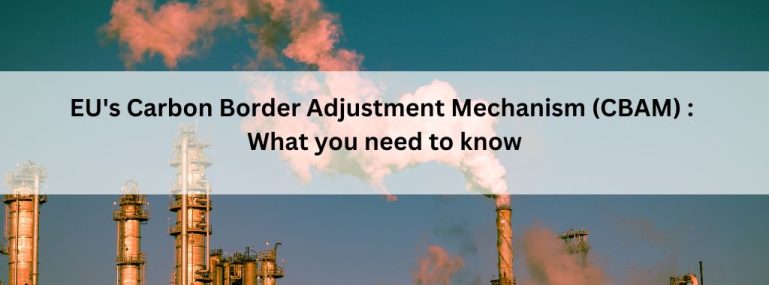Climate change is a global emergency that needs to be addressed by all regions across the globe. The European Union, the leader in climate protection and the driving force of the world’s environmental agenda, aims to become the world’s first climate continent by 2050. The Carbon Border Adjustment Mechanism is the EU’s instrument to put a fair price on carbon emitted during production of carbon intensive goods entering the EU and promote strict rules among non-EU countries.
CBAM will ensure that the carbon price of imports is equal to the carbon price of domestic production, this prevents carbon leakage. Carbon leakage occurs when companies based in the EU move the production of carbon intensive products outside the EU where the less stringent climate policies are in place. The CBAM is designed to be compatible with the WTO guidelines and ensures the EU’s objectives are not undermined.
CBAM will be implemented from 2026 while the current transitional phase lasts between 2023 to 2025. This measured implementation is made to be aligned with the phase-out of the allocations of free allowances under EU’s Emissions Trading System (ETS) to support decarbonization of EU industry.

CBAM Transitional Phase (2023-2025)
CBAM entered its transitional phase on October 1, 2023, with the first reporting period for importers ending on January 1, 2024. This measured approach allows both EU and non-EU businesses to systematically plan their transition.
CBAM’s initial application will be on the import of goods and selected precursors whose production is highly carbon intensive and at the most significant risk of carbon leaking: cement, iron and steel, aluminum, fertilizers, electricity, and hydrogen. When fully phased out- CBAM will cover over 50% of the emissions in ETS covered sectors. This transitional phase will serve as a pilot and learning periods for all importers, producers and authorities and collect all the relevant information required to identify all the shortcomings and refine the methodology.
This transitional period will require firms importing goods under the scope of the new rules to only report Greenhouse Gas Emissions (GHG) embedded into their imports (direct and indirect), without the need to buy or surrender certificates. Indirect emissions for some sectors (cement and fertilizers) will be included after the transition period, based on the methodology outlined in the Implementing Regulation published on 17th August 2023.
The Implementing Regulation on reporting requirements and methodology provides for some flexibility when it comes to the values used to calculate embedded emissions on imports during the transitional phase. Until the end of 2024, companies will have the choice of reporting in three ways: (a) full reporting according to the new methodology (EU method); (b) reporting based on an equivalent method (three options); and (c) reporting based on default reference values (only until July 2024). As of 1 January 2025, only the EU method will be accepted, and estimates (including default values) can only be used for complex goods if these estimations represent less than 20% of the total embedded emissions.
CBAM Regime from 2026:
- EU importers of goods covered by CBAM will register with national authorities where they can also buy CBAM certificates. The price of the certificates will be calculated depending on the weekly average auction price of EU ETS allowances expressed in €/tonne of CO2 emitted.
- EU importers will declare the emissions embedded in their imports and surrender the corresponding number of certificates each year.
- If importers can prove that a carbon price has already been paid during the production of the imported goods, the corresponding amount can be deducted.
ComplianceXL offers expert guidance to businesses navigating regulatory landscapes like CBAM, ensuring seamless compliance and operational continuity. Contact us today to identify areas in your operations needing attention for CBAM compliance, safeguarding your business from disruptions and enhancing sustainability efforts.





